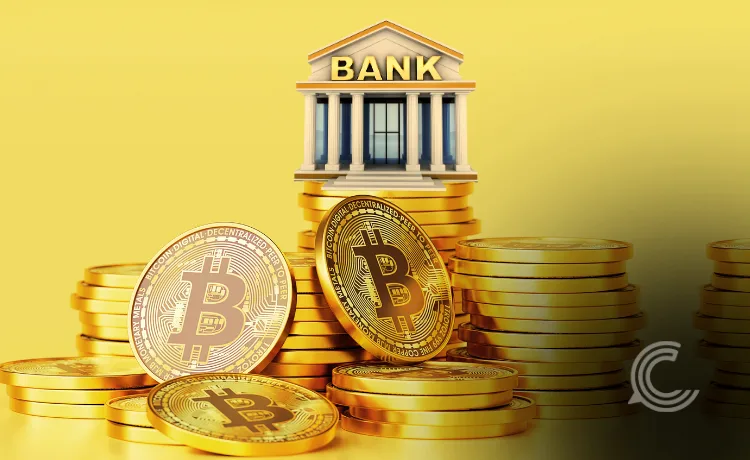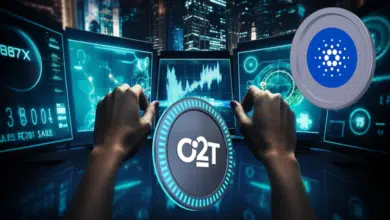Deutsche Bank Predicts Bitcoin Will Join Central Bank Reserves by 2030

- Bitcoin as a Reserve Asset: Deutsche Bank predicts Bitcoin (BTC) will join central bank reserve assets like gold and the US dollar by 2030, despite being “backed by nothing”
- The shift is driven by reduced volatility, increasing institutional adoption, and Bitcoin’s function as a hedge against inflation and geopolitical risk
- Analysts view Bitcoin as a complementary diversification to gold in central bank portfolios, not a replacement for the US dollar
The Deutsche Bank strategists from the research section have made a very bold forecast that by 2030, Bitcoin would be a full-blown central bank reserve asset despite being “backed by nothing”. The prediction is especially significant since the reserve assets are traditionally characterized by stability and liquidity which the fluctuating cryptocurrency has traditionally lacked.
The bank analysts, such as Marion Laboure and Camilla Siazon, admit that Bitcoin is supported by “nothing at all,” which is the opposite of the currencies supported by the government credit, or past experiences, such as gold. However, they argue that the evolving market dynamics are moving Bitcoin to a point where it is “almost there” as a viable reserve asset, as cited by Fortune.
The Case for Bitcoin’s Maturity
The core of Deutsche Bank’s bullish case rests on several recent developments that suggest Bitcoin is maturing from a purely speculative investment into a more stable financial instrument. One key factor is the decline in its volatility. The report notes that the Bitcoin’s 30-day volatility has reached historic lows as its price soared to new record highs, indicating a structural shift away from its purely speculative roots.
The decreased volatility is largely attributed by deepening institutional adoption. Spot Bitcoin Exchange-Traded Funds (ETFs) approval in the US in 2024 have significantly increased liquidity and attracted massive inflows from institutions into the Bitcoin sector with one prominent Bitcoin ETF approaching a staggering $100 billion in assets under management. This influx of professional money is stabilizing the market and increasing the overall liquidity of the asset a prerequisite of central banks.
Bitcoin as Digital Gold Hedge
Central banks carry reserves to control the exchange rates as well as act as a financial buffer in periods of stress. The Deutsche bank analysis also puts Bitcoin as an alternative to the US dollar, which is unlikely to lose its prominence, but rather as a complementary hedge to gold.
The comparison can be described as an interesting historical analogy, which implies that the price of Bitcoin since 2012 is more or less parallel to the one of gold since 1920, as both of these assets go through the stages of extreme volatility before gaining wider acceptance.
In addition, both assets have a low correlation to standard asset classes, and they provide scarcity (the limited supply of bitcoin), which is a desirable hedge against inflation and geopolitical risk, which worries the global policymakers.
A Reaction to the CBDC Push
The forecast made by the bank gains a unique geopolitical dimension viewed against the backdrop of the global race to develop Central Bank Digital Currencies (CBDCs). Whereas CBDCs are a centralized and government-regulated type of digital currency, Bitcoin is a decentralized alternative.
The move by central banks to consider Bitcoin can be seen as a non-obtrusive, proactive step to have portfolio diversification in a increasingly fragmented digital financial landscape.
By holding a decentralized asset like Bitcoin, Central banks can hedge against the risks associated with a potential future, for example, US dollar has reduced its global reserve market share, or their own CBDC initiatives are upended by domestic pressures, such as privacy issues and slow or sluggish public adoption. The final objective is to provide a working alternative, especially in the emerging markets where the local currency instabilities make the Bitcoin a more appealing, viable solution.
Wrapping Up
Although the prediction might come true, there are still great challenges to be overcome. Some of the largest institutions such as the US Federal Reserve and the European Central Bank have so far not approved the idea of having Bitcoin in their balance sheets . The world bank too has raised concerns and opined that crypto assets are not yet in the minimum qualifications of a reserve asset.
The Deutsche bank report however states that these barriers will eventually be overcome by time, regulatory transparency and further maturation of the market. As pro- crypto regulation is gaining pace, including in the form of the Markets in Crypto-Assets (MiCA) regulation in the EU, institutional and governmental custody infrastructure is advancing at a rate that would allow the shift with the next generation speculative asset to reserve asset to become a reality by 2030.



